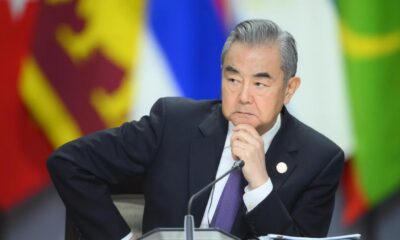Asia
Pakistani Taliban TTP emboldens, killing four soldiers

At least four Pakistani soldiers were killed when Pakistani Taliban (TTP) attacked two military posts along Afghanistan-Pakistan border in Chitral. Pakistan claims that a “large group of terrorists” stormed security outposts, promoting fierce clashes where 12 assailants were also killed in the clashes.
The terrorists carried out attacks on two separate outposts in the Kalash border valley, where the soldiers repulsed the attack. The assailants were equipped with the latest weapons, according to the Inter Service Public Relation (ISPR) news release.
Terrorists’ movement and concentration in Gawardesh, Pitigal, Barg-e-Matel and Batash areas of Nurstan and Kunar provinces of Afghanistan, according to the statement.
The military’s media wing also said that these issues had already been picked up and were timely shared with the Taliban government in Afghanistan.
Pakistan’s home-grown Tehreek-e-Taliban Pakistan (TTP) has claimed responsibility for the raid and said its fighters inflicted heavy casualties on Pakistani soldiers. The banned TTP also claimed its fighters seized Pakistani soldier’s weapons while overrunning their posts.
However, the Pakistani officials accuse the Taliban for harboring the TTP and said TTP fighters have fled and taken shelter in Afghanistan. But the Taliban government had time and again denied the charges, saying that no one can use Afghan soil against other countries, including the neighbor Pakistan.
TTP and Afghan Taliban strongly ties
It has been widely believed among the Pakistani authorities that TTP has been emboldened after the return of power of the Taliban in Afghanistan as the group carried out attacks against Pakistani targets in the last two years.
The Taliban overtake Afghanistan in August 2021, and also hosted two rounds of talks between the TTP members and Pakistani delegation in Kabul in order to reach peace between the two sides.
In June this year, there was a renewed push by the Taliban to restart talks between TTP and Pakistan, where Pakistani officials had already met with TTP Chief to discuss peace. There was no official confirmation, but recently TTP chief Noor Wali Mehsud met with a Pakistani delegate as part of efforts to explore more on the possibility of resumption talks that were called off in November last year.
Though the Pakistani officials seemed reluctant to carry talks with TTP and laid down a clear condition that TTP will have to surrender first for any dialogue. Apparently, the Afghan Taliban is more eager for the talks as they continue to push for the rapprochement. In May, when the Taliban Foreign Minister Amir Khan Muttaqi visited Islamabad, had asked for resumption of talks with TTP but the Pakistani side was not interested.
Pakistan is no longer interested in direct talks with TTP
The Pakistani officials had said that they will not directly speak with the TTP, and if there were any talks in the future, it would be conducted through the Afghan Taliban. At the same time, Pakistani authorities were disappointed with the Taliban for harboring the TTP, and somehow the Taliban will never use force against the TTP because they are “ideological cousins”.
The Afghan Taliban has been making efforts to find a middle ground or a workable solution to address the TTP issue and engage in talks with the Pakistani sides for resumption of talks.
At the same time, Pakistan didn’t want confrontation with the Afghan Taliban and had called on the international community to stay engaged with Afghanistan. Pakistan is willing to continue working with the Afghan Taliban despite their failure to act against TTP.
Pakistan Caretaker Prime Minister, Anwaar-ul-Haq Kakar on Thursday reaffirmed the country’s strong resolve to get rid of its state of terrorism.
“Thanks to our alert forces, the terrorist attack on military posts near the Pak-Afghan border in Chitral, was repelled with heavy casualties on the terrorist side. Sadly, four brave soldiers embraced Shahadat. Our resolve to eradicate terrorism remains unshaken, and all our citizens stand firm with us,” Kakar tweeted.
Meanwhile key crossing border still remained close
A key border crossing between Pakistan and Afghanistan remained closed for a second consecutive day on Sumpter 7 one day after deadly clashes between the Taliban and Pakistan security forces at Torkham gate. Taliban officials said that authorities of the two neighboring countries are trying to work to determine the reason for the clashes.
Torkahm, which is considered as the main gateway for trade and travel, has remained closed to all vehicular and pedestrian traffic. It has been reported that more security forces from both sides have been dispatched in the bordering areas and tension remains very high.
It has been said that both sides transformed heavy weapons on the side, and more troops are stationed. However, no clashes have been reported since yesterday.
Asia
Japanese prime minister warns of US tariffs’ impact on global economy

Japanese Prime Minister Shigeru Ishiba warned on Monday that US tariffs could disrupt the global economic order. However, he also emphasized that Japan would seek common ground with the US on how the two countries could cooperate on various issues, from trade to national security.
“When negotiating with the US, we need to understand the logic and emotional elements behind Trump’s views,” Ishiba said in a parliamentary speech.
“I am fully aware that what has happened so far has the potential to disrupt the global economic order,” he said.
Japanese Prime Minister Ishiba also stated that the government is not currently considering issuing a supplementary budget but is ready to take timely action to mitigate the economic impact of US tariffs. Ishiba had previously described Trump’s tariffs as a “national crisis” for Japan. Ishiba stated, “We must call this a national crisis. The government will do everything possible to respond to this crisis affecting the entire country.”
These statements come before the start of bilateral trade talks on Thursday, which are expected to cover various issues, from tariffs and non-tariff barriers to exchange rates.
In his latest statement on tariffs on Sunday, Trump said he would announce the tariff rate to be applied to imported semiconductors within the next week.
Economy Minister Ryosei Akazawa, Japan’s top negotiator in trade talks with the US, said any discussion of exchange rates would take place between Japanese Finance Minister Katsunobu Kato and US Treasury Secretary Scott Bessent.
“Both countries share the view that excessive market volatility will have negative effects on the economy,” Kato said at the same parliamentary session.
Trump’s tariffs are expected to hit the Japanese economy hard. A failed response from Ishiba could become a liability for the prime minister as he leads his party into upper house elections this summer.
Prime Minister Ishiba’s cabinet was already shaky within the LDP and suffering from low approval ratings. His government faces a difficult task, including persuading affected industries within the country to comply with the outcome of negotiations and preparing aid measures.
Asia
Taiwan courts Trump amidst tariff reprieve

When US President Donald Trump stated that he would impose a 32% “reciprocal” tariff on Taiwanese exports, Taiwan’s leader, Lai Ching-te, responded cautiously. With Trump’s decision to delay, a critical 90 days awaits the Lai administration.
Since Trump’s return to the White House in January, Taiwan has made significant efforts to gain favor with Trump and maintain unofficial relations. The largest chip manufacturer, Taiwan Semiconductor Manufacturing Co. (TSMC), has pledged a $100 billion investment in the US, a move supported by Lai. Last month, Taiwan hosted Alaska’s Republican Governor, Mike Dunleavy, a Trump ally, and planned to import liquefied natural gas from the state. The Lai administration has also aligned with US calls for increased defense spending, promising to raise it to 3% of gross domestic product (GDP).
Trump still included Taiwan on his tariff target list. However, his abrupt decision to halt tariffs, except for a 10% baseline rate for everyone, may have opened a “bargaining” window for Taiwan to persuade Trump.
“Now that we have another 90 days, we can discuss Taiwan-US economic and trade cooperation in more detail and depth,” Taiwan’s Foreign Minister, Lin Chia-lung, told reporters on Thursday.
Lin praised the potential collaboration, stating, “We hope to create a joint fleet approach by leveraging the US’s enormous market, excellent technology capital, and talent in a Taiwan-US coalition.”
According to local media, Lai said on Friday that Taiwan was among the “first” on the list for discussions with the Trump administration.
Expressing confidence in Taiwan’s economy in a special broadcast last week, Lai emphasized strengthening industrial cooperation with the US and upgrading Taiwanese industries in global supply chains.
“Taiwan has no plans to adopt retaliatory tariffs to address the US’s reciprocal tariffs. There will be no changes to corporate investment commitments to the US as long as they are consistent with national interests,” Lai stated.
He added, “At the same time, we must ensure that the US clearly understands Taiwan’s contributions to US economic development.”
In an op-ed published by Bloomberg this week, Lai detailed his planned approach. He stated that his administration is willing to reduce its tariffs to zero “on a reciprocal basis with the US.” He also pledged to expand purchases of American goods, continue additional arms purchases, continue making new investments “across the US,” and remove non-tariff barriers while addressing US concerns about export controls and improper transshipment through Taiwan.
“Lai’s approach to foreign relations is cautious and focused primarily on US relations, and secondarily on Japan,” said Rupert Hammond-Chambers, President of the US-Taiwan Business Council.
Hammond-Chambers noted that the sentiment of “deterring China” brings with it the understanding that strong relations with America “must be maintained at all costs.”
In a speech in February, Lai emphasized shared values and expressed gratitude for Trump’s support. Lai pledged to continue reforming and improving defense to encompass “the entire society” and to prioritize special budget allocations to ensure defense spending exceeds 3% of GDP.
The US government has supported Lai’s security reforms, with the de facto American Ambassador, Raymond Greene, openly expressing this support.
TSMC’s $100 billion investment marks the latest in a wave of companies committing large sums to the US: Taiwan and the US are preparing to sign a long-awaited agreement to end double taxation, which will smooth the path.
Hammond-Chambers said that Lai’s approach has so far been well-received among Republican legislators and Trump administration officials.
Asia
Japanese yen hits 7-month high amid trade war fears

The Japanese yen appreciated against the dollar on Friday afternoon, causing the exchange rate to fall below 142. The yen reached its highest level in approximately seven months as the escalating US-China trade war triggered a sell-off of the dollar against other major currencies.
The yen gained nearly 3% against the dollar. Other Asian currencies also strengthened, with the Malaysian ringgit rising 0.72% against the dollar. The South Korean won and the Singapore dollar also appreciated. The euro strengthened against the dollar to levels not seen since February 2022.
Shoki Omori, a global desk strategist at Mizuho Securities, stated, “The yen has risen because there is clearly a risk-off mood in the markets, with Trump imposing larger-than-expected tariffs on China.”
Omori added that recent sell-offs in US Treasury bonds have led investors to move away from the dollar and towards safe-haven assets such as the yen, Swiss franc, and gold. Japan’s large economy, political stability, and liquid financial markets make its currency an attractive safe-haven asset.
US Treasury bonds are traditionally viewed as a low-risk, safe-haven investment. However, the intensifying trade war has increased uncertainty, prompting investors to exit these assets and move into cash.
In the latest escalation of the trade war, China raised its retaliatory tariff rate against the US to 125%. US President Donald Trump had already increased tariffs on China to 145%, even while halting “reciprocal” tariffs on exports from other countries.
The tit-for-tat tariffs caused US stocks to fall sharply on Thursday, while concerns about the economic consequences dampened investor sentiment.
Weakness in US Treasury bonds has played a role in the yen’s strengthening. On Friday morning, the 10-year US Treasury bond yields, a benchmark for long-term interest rates, rose to 4.46% after falling below 4% following Trump’s announcement of new tariffs on trade partners last week. Bond yields move inversely to prices.
The yen typically weakens when US bond yields rise and widen the gap with Japanese bond yields, but strong safe-haven flows have overridden the usual downward pressure on the yen.
Omori from Mizuho predicted that 10-year US Treasury bond yields would fall as the year progresses. Omori estimates that the Federal Reserve will cut interest rates at least two to three times, depending on the health of the US economy.
He stated that a downturn in the US economy would mean lower yields on 10-year Japanese government bonds. “Of course, we may experience shocks depending on what happens in the US, and we must not forget that the Japanese government may issue more bonds for fiscal policy,” he said.
The yen’s appreciation dragged down the share prices of Japanese exporters on Friday. Shares of Nissan Motor closed down 6%, while shares of Toyota Motor fell 5%. Technology stocks such as Furukawa Electric lost around 6% in value.
-

 America6 days ago
America6 days agoThe economic mind of Trumpism — 1: Stephen Miran and his dollar devaluation plan
-

 Middle East2 weeks ago
Middle East2 weeks agoIsrael bombs Syrian base T4, reportedly warning Türkiye against military presence
-

 Europe2 weeks ago
Europe2 weeks agoSerbia and Hungary sign comprehensive military cooperation agreement
-

 Diplomacy2 weeks ago
Diplomacy2 weeks agoMeta fined significantly in Türkiye for defying content removal orders
-

 Diplomacy7 days ago
Diplomacy7 days agoTrump’s tariffs boost interest in German, Japanese bonds
-

 America6 days ago
America6 days agoUS considers delisting Chinese stocks amid trade tensions
-

 Europe2 weeks ago
Europe2 weeks agoEuropean right gathers at Israeli government event on antisemitism
-

 Diplomacy2 weeks ago
Diplomacy2 weeks agoUS harms its own reputation with trade wars, Wang Yi says


















